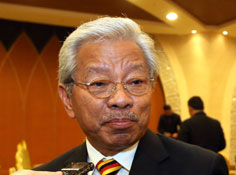
Tan Sri Datuk Amar Dr James Masing
KUCHING: The state’s road network has expanded by 50 times from just 600 km 50 years ago to over 30,000 km today.
Unlike now, 50 years ago the roads were mostly in major towns of Kuching, Sibu and Miri and the main mode of transport then was by river, noted Deputy Chief Minister Tan Sri Datuk Amar Dr James Masing.
However, today, the road network does not only link up cities and towns but has been extended to coastal villages and remote interiors, he added.
“Certainly, the much improved road connectivity has greatly reduced travel time and costs, lowered the cost of living and improved the overall quality of life of the people. This cannot be denied by all concerned.
“However, Sarawak, being a large state with land area of over 124,000 square kilometres, and almost equal to Peninsular Malaysia, still has a long way to go in terms of road connectivity to all the more than 5,000 villages scattered in the state.
“As compared to Peninsular Malaysia with a population density of approximately 180 persons per square kilometre, Sarawak has a population density of only 20 persons per square kilometre (population of about 2.6 million),” Masing said when declaring open the Road Connectivity Lab 2016 here yesterday.
Masing, who is also Infrastructure Development and Transportation Minister, said road infrastructure was one of the key means of connectivity in Sarawak, adding that an extensive road network was vital to bring people closer to mainstream development, especially the folk living in rural areas.
“Sarawak’s topography is faced with undulating terrains in the interior and deep peats and large river crossings in the coastal and central regions and is very much unmatched in Peninsular Malaysia. It is indeed very challenging in terms of development enhancement.
“Therefore, it is a very tall order to connect all villages and longhouses in every nook and corner of the state by road. Rome is not built in one day but with tenacity, energy and commitment by all quarters especially the planners, politicians like us and implementers, one day, I hope all inaccessible villages will be connected by at least an R1 road if not R3. Our target is 2030.”
As a minister in charge of Infrastructure Development and Transportation, Masing said one of his top priorities was to focus on improving accessibility to rural areas in order to open up more land for development to boost the people’s economic well-being.
“This augurs well with the state government’s Rural Transformation Programme to improve the road network infrastructure to remote and isolated areas for better connectivity and improved quality of life.”
On the Road Connectivity Lab, he said it was an initiative by his ministry, the Public Works Department, the Resident’s Offices, District Offices and other relevant agencies to develop a database on road connectivity in Sarawak.
“Road Connectivity Lab 2016 aims to re-visit the percentage of connectivity to settlements registered with the district offices throughout all the divisions in Sarawak and also identify the lacking infrastructure gaps and address them accordingly.”
